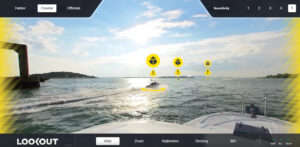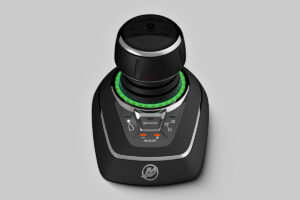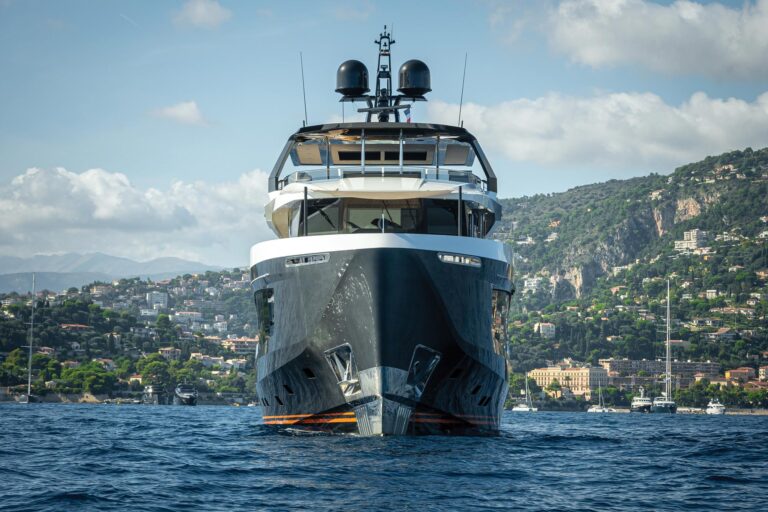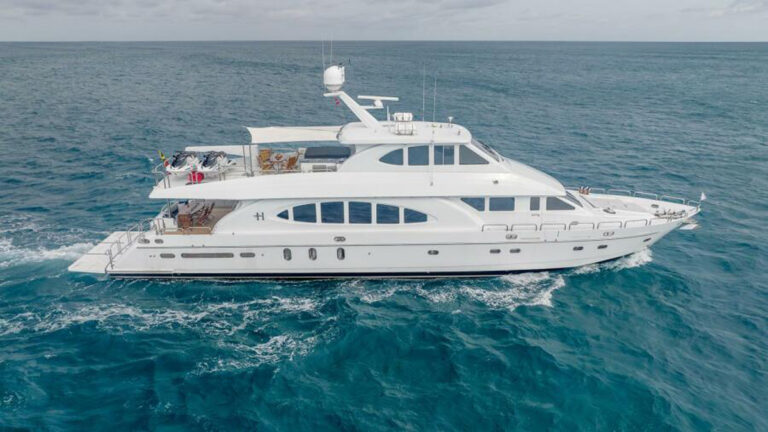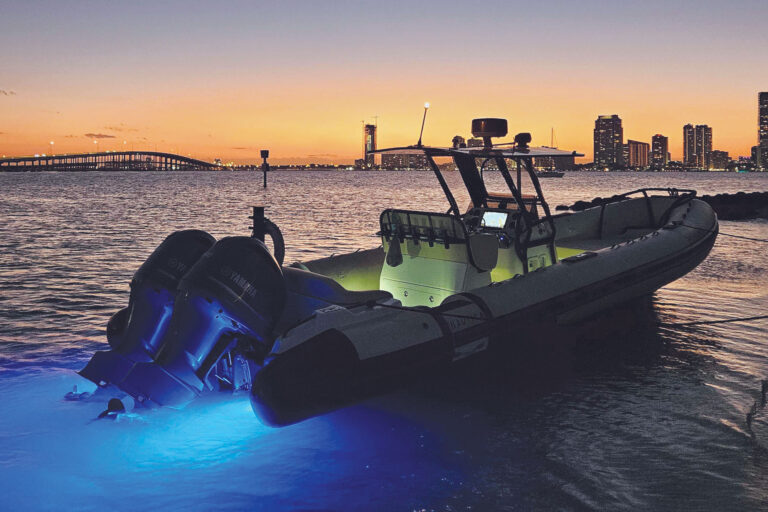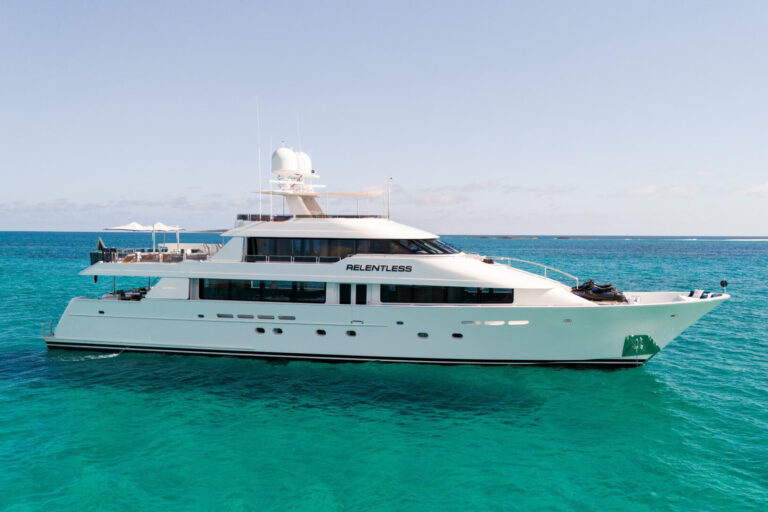Today’s fishfinders are available in a bewildering range of types and sizes, ranging from small portable units to the “underwater radar sonar systems whose sound heads descend from the bottom of the hull to scan the sea in all directions. Multifunction, integrated products are increasingly common, providing the ability to display a variety of information, radar, cartography and sonar, on one screen, in split screen or in many cases as overlays of data from different but related sources. While most units are stand-alone devices, “black box fishfinder modules that present information on multifunction display screens are becoming increasingly popular. The systems identified as “networked can go one step further, allowing the data from a sensor (a fishfinder for example) to be displayed in different formats on different screens with individual control of what is shown on each display. The introduction of equipment using digital signal processing (DSP) provides excellent results with little or no intervention by the user, while equipment that provides a full range of operator controls can excel in the hands of a skilled user.
Furuno
**** Furuno’s new recreational fishfinder range includes 10 different product packages. These range from the 600- to 1,000-watt, 50/200 kHz black box NavNet Fish Finder module to sector and Searchlight sonar units capable of scanning the ocean in all directions, up to distances of 6,000 feet. Fishfinder units are available with CRT, monochrome or color LCD screens in sizes ranging from 5 to 10.4 inches (measured on the diagonal, a standard for all marine displays). Power choices begin at 300 watts and extend to a full 3 kW, with frequencies between 28 and 200 kHz. The Network Sounder designed to work with the NavNet and NavNet vx2 units (providing control and display of radar, chart and sonar information), provides ranges of 2,500 and 3,600 feet, selectable power output of 600 W/1 kW and 1/2/3 kW and uses sonar frequencies of 500/200 kHz and 28/38/50/88/107/200 kHz. Their Searchlight sonar can be found on the larger offshore fishing boats. Furuno’s sonar products reflect the company’s extensive history and success in producing sonar devices for the world’s fishing fleets. Contact: www.furunousa.com.
Garmin
Garmin, a company primarily known for its development of GPS-based navigation systems for aviation, marine and terrestrial use, offers a total of six fishfinder products ranging from the entry level Fishfinder 80, a 200 kHz monochrome (64 x 128 pixels) display with a maximum 600-foot depth capability, to the 320C, a dual-frequency (50-200 kHz) 500-watt (RMS, 4,000-watt peak-to-peak) unit that features a 5-inch diagonal (234 x 320 pixels) sunlight-readable 16-color TFT display. In addition to its dedicated fishfinder products Garmin also offers the black box model GSD 20, a 500-watt (RMS) dual-frequency sounder module whose output data can be displayed on six of their high-end GPSMap plotters. Contact: www.garmin.com.
JRC
Japan Radio Company, Ltd. (JRC) produces a wide range of sonar products for fishing including omni directional and scanning sonar, the dual-frequency JFV-130 color CRT and the FF 50 color LCD screen unit. The Plot 500F combines a C-Map NT based chart plotter with a 50/200 kHz, 600-watt RMS (4,800 watts peak-to-peak) fishfinder. The new JFC-130 black box dual-frequency echo sounder is the latest addition to their fishfinder range. It is available with a choice of 1 kW or 3 kW RMS power output sonar transmitters and can operate with a wide range of frequencies ranging from 28 to 200 kHz. The basic unit employs a 10.4-inch color LCD screen usable in either portrait or landscape mode. The output from the sounder is available as a VGA signal for display on additional screens. Contact: www.jrcamerica.com.
Lowrance
Lowrance, a pioneer in applying sonar for the benefit of the recreational angler, offers an overwhelming range of fishfinding devices (some 30 products in all). Of prime interest is Lowrance’s 10.4-inch screen combination chart plotter/sonar units, the LCX-104C (50/200 kHz, 1 kW RMS, 8,000- to 4,000-watt peak-to-peak power), the LCX-110C with its higher resolution, 600 x 800 pixel SVGA color TFT LCD and the LCX-111C HD, which incorporates a 20 GB hard drive preloaded with charts of U.S. coastal waters, including Hawaii and Alaska, the Great Lakes and over 2,100 other inland bodies of water. For those who like to drill holes in frozen water in order to go fishing, consider the X67C Ice Machine, and its companion GPS-capable M68C S/Map, both portable 200 kHz rechargeable battery-powered units. Contact: www.lowrance.com.
Navman
Navman’s product line includes seven fishfinders, three using monochrome displays, and the other four with color LCD screens ranging from 3.5 to 6.4 inches. Transmit power ranges from 200 watts RMS for the smallest single-frequency unit to 600 watts RMS, 3,300-foot maximum range with dual-frequency operation for the 5- and 6.4-inch display models. Navman recently introduced a combined chart plotter/fishfinder unit, the Track Fish 6600 with a 7-inch, 800 x 480 pixel color screen. A dual-frequency unit operating at 600 watts RMS, the maximum depth is 3,300 feet. This unit uses the latest C-MAP NT cartography with multiple split-screen display choices. All of the Navman fishfinders with 3.8-inch or larger screens can accept data from accessory fuel flow sensors. The Fish 4600 6.4-inch screen fishfinder and the Track Fish 6600 are compatible with Mercury’s SmartCraft engine data system, as well as the new C-Map NT MAX charts. Contact: www.navman.com.
Raymarine
Raymarine offers a wide array of sonar products in both stand-alone integrated multifunction and black box models. All of their current fishfinders use their High Definition Fish Imaging (HDFI) technology, introduced in the DSM 250 black box sonar. The sounder uses very high-speed digital signal processing (DSP) to continually optimize the performance of the system, with particular emphasis on the receiver circuits to extract the maximum amount of useful information from the returning sonar signal, without the need for adjustment by a skilled operator. The latest black box digital sounder module, the DSM300 provides dual-frequency (50 and 200 kHz) operation with transmit power output of 600 or 1,000 watts RMS. Maximum depth extends to 5,000 feet in ideal conditions. The module is compatible with Raymarine’s C-Series and the latest E-Series multifunction navigation displays. Contact: www.raymarine.com.
Simrad
Simrad’s four models are designed to cover the requirements of the commercial or sports fisherman as well as the need for a navigational echo sounder. The dual-frequency, 50/200 kHz EQ33’s 600-watt RMS (2,400-watt peak-to-peak) transmitter allows sounding to a maximum range of 3,000 feet with data displayed on its 6-inch color LCD. The EQ44 (10-inch display) and EQ54 (15-inch display) provide dual, 1,000-watt RMS transmitters with a maximum range of 5,400 feet and can display information obtained from two different frequencies at the same time. The new ES60 can operate with single-, dual- or split-beam transducers over a frequency range from 12 to 200 kHz with up to 4 kW RMS power from each of its transmitters. It is available with five different screen sizes from 10 to 23 inches and supports XVGA resolution of 1024 x 768 pixels. The ES60 is kept up-to-date with Simrad’s latest system improvements through the use of system software updates supplied on CDs to be read by the system’s built-in CD-ROM reader. Contact: www.simradusa.com.
SI-TEX
The SI-TEX fishfinder lineup is comprised of six models. The single-frequency Profish III uses a 4.8-inch transflective direct sunlight-readable LCD to show the information gathered by its 200-watt RMS (1,600-watt peak-to-peak) transmitter and processed by the 24 MHz, 16-bit CPU. The Profish II Map/Sounder employs a similar but larger, 5.7-inch LCD and is fitted with dual slots for C-MAP NT chart cards that operate in conjunction with the 18-channel WAAS/EGNOS GPS receiver provide full chart-plotter capability. The sonar system uses a 300-watt RMS (2,400-watt peak-to-peak) transmitter that operates at 120 kHz to provide depth ranges up to 1,500 feet. A less costly companion model of the Profish II provides all of the capability of the Map/Sounder version without the chart-reference capability but with a full-function track plotter. At the other end of the spectrum the CVS-210 is a 10-inch dual-frequency (50 & 200 kHz), color CRT display sounder equipped with a 1,000-watt RMS (8,000-watt peak-to-peak). The SI-TEX fishfinder model range is rounded out with four dual-frequency color LCD screen units: the 300-watt, 5.6-inch CVS-106L; the 6.5-inch CVS-832/832C (600- or 1,000-watt transmitters); the 8-inch screen CVS833/833C (600 or 1,000 watts); and the 10.4-inch screen CVS-841, with a multifrequency, 28-200 kHz, 1 kW/3 kW transmitter. Contact: www.si-tex.com.



